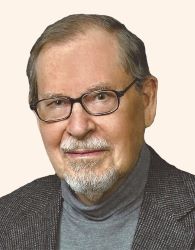
Alan Veith: An ASTM Life
Alan Veith quit what he called his “day job” 28 years ago. But he has never stopped working for ASTM International. In fact, his tenure could very well be a record, though current membership records do not stretch back far enough to confirm.
After receiving a B.S. degree in physical chemistry from the University of Kentucky in 1949 and an M.S. degree in polymer science from the University of Akron in 1956, Veith kicked off his career as an ASTM member in June 1952 with the presentation of two scientific papers at a symposium of the committee on rubber and rubber-like materials (D11) in New York. And now, 67 years later, he’s helping to write a new standard on test method bias in inter-laboratory testing, as well as a revision to the practice for evaluating precision for test method standards in the rubber and carbon black manufacturing industries (D4483).
Now 93, Veith retired in 1991 after a 42- year career in research and development in the rubber industry, 38 years of which were spent with tire company BFGoodrich (the final four were with newly formed Uniroyal-Goodrich).
All of this took place before email became the standard means of business communication. When email took hold in the mid-1990s, Veith says he quickly took advantage of this new technology to continue his participation in ASTM, long after his working career had ended.
READ MORE: Recycling Ruber into rCB
“The capability to be in touch with anyone electronically has enabled me to continue to work with ASTM,” he says. “Before email, you had faxes and ordinary postal mail. Communication was at a more relaxed pace. But I wouldn’t have been able to work from home without email.”
“After 67 years with ASTM, I haven’t given up and coasted along,” Veith adds.
His list of ASTM accomplishments is long, but some things top the list. In 1978, he received the Award of Merit for outstanding contributions to D11 standardization. “That was at the midpoint of my career in D11. I was very proud of that.”
He’s the main contributor and author of 18 ASTM International standards, many for the committee on rubber and rubber-like materials, and a major contributor to eight other standards. In fact, he has organized the required interlaboratory test programs and prepared precision sections for approximately 60 ASTM test method standards, he says.
He’s particularly pleased to have had the opportunity to draft the precision evaluation standard (D4483) and the rubber reference material (IRM) standard (D4678).
Through it all, he has maintained two policies in standards work: 1) Be clear and complete in drafting the standard, including all details while making it readable; and 2) Include tutorial content when needed.
“A standard should not be drafted to be understandable only to experts in the particular testing community. It should be drafted to be understandable to the novice in the testing community to which the standard applies,” Veith says.
In 2004, he reached another high point. That year, he received the inaugural Robert D. Stiehler Award for longtime service, leadership, and contributions to the committee on rubber and rubber-like materials (D11) and ASTM International. In 2012, he received a Lifetime Achievement Award from the committee on tires (F09) for his extensive contributions to the development of tire performance standards.
What about the changes he’s seen at ASTM during his long tenure? Some are obvious, others a bit more obscure.
“In the early years, the chairs who head committees and subcommittees were usually in that job a long, long, time,” he says. “Sometime in the 1960s or 1970s, ASTM said the chair of a subcommittee could have three two-year terms and could continue with additional terms with a special waiver. That way, if no one else had the experience, the chair could remain in that position.”
He welcomed the new rule.
“It’s better to rotate and bring new blood into addressing the organization of various committees and subcommittees,” he says.
The technology infrastructure of ASTM has changed as well. Around 1960, Veith recalls ASTM acquiring a mainframe computer and beginning to store its membership rolls there. For this reason, current ASTM records show his membership beginning in 1960. Prior to this, membership records for Veith’s committee were maintained by the committee secretary and kept in files at his/her company office.
His only regrets are that most of his peers have passed on and that he can no longer travel to meetings due to mobility issues.
Veith and his wife, Rosemary, now live in a retirement community in Austin, Texas, and his three children are engaged in successful engineering/ technical endeavors of their own in their professional lives. He gives special credit to Rosemary for continued encouragement and support throughout his 67 years with ASTM International.
Jean Thilmany is a freelance writer based in St. Paul, Minnesota. She has written for Mechanical Engineering Magazine, Engineering.com, and other publications.
 SN Home
SN Home Archive
Archive Advertisers
Advertisers Masthead
Masthead RateCard
RateCard Subscribe
Subscribe Email Editor
Email Editor